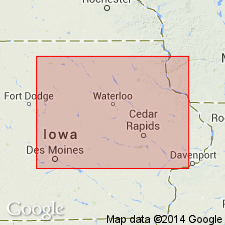
- Usage in publication:
-
- Eagle Center Member
- Modifications:
-
- Named
- Reference
- Dominant lithology:
-
- Dolomite
- AAPG geologic province:
-
- Iowa shelf
Summary:
Named as a member of Little Cedar Formation (new) of Cedar Valley Group (rank raised). Used in northern IA. Type locality designated at Waterloo South Quarry, SW NW NW sec 18, T87N, R12W, Black Hawk Co, IA on the Iowa shelf. The quarry is 5 km east of village of Eagle Center. Is 9+ m thick at type where member is primarily a cherty dolomite. Reference section [not described here] designated near Raymond, IA (Anderson, Garvin, 1984, p. 33, beds 11-15). The dolomite is sparsely fossiliferous to nonfossiliferous, burrowed, argillaceous. Chert occurs as both nodules and bands. Basal contact with Bassett Member (revised) of Little Cedar chosen above the non-cherty calcarenitic beds. Locally overlies and intertongues with Chickasaw Shale Member. Southeast of type, member is dominated by sparsely fossiliferous to nonfossiliferous, burrowed, cherty, argillaceous calcilutite. Contains stromatoporoids or corals, and is biostromal. Ranges between 8 to 11 m where it overlies Bassett, and 1.4 to 4.2 m where it overlies Chickasaw. Underlies Hinkle Member, top member of Little Cedar Formation. Has conodont of the Lower SUBTERMINUS fauna. Belongs to middle Givetian, Middle Devonian. Also has brachiopods, bryozoans, crinoids, corals, rostroconchs. Deposited in inhospitable bottom conditions. Cross section. Nomenclature charts. Graphic sections.
Source: GNU records (USGS DDS-6; Denver GNULEX).
For more information, please contact Nancy Stamm, Geologic Names Committee Secretary.
Asterisk (*) indicates published by U.S. Geological Survey authors.
"No current usage" (†) implies that a name has been abandoned or has fallen into disuse. Former usage and, if known, replacement name given in parentheses ( ).
Slash (/) indicates name conflicts with nomenclatural guidelines (CSN, 1933; ACSN, 1961, 1970; NACSN, 1983, 2005, 2021). May be explained within brackets ([ ]).

